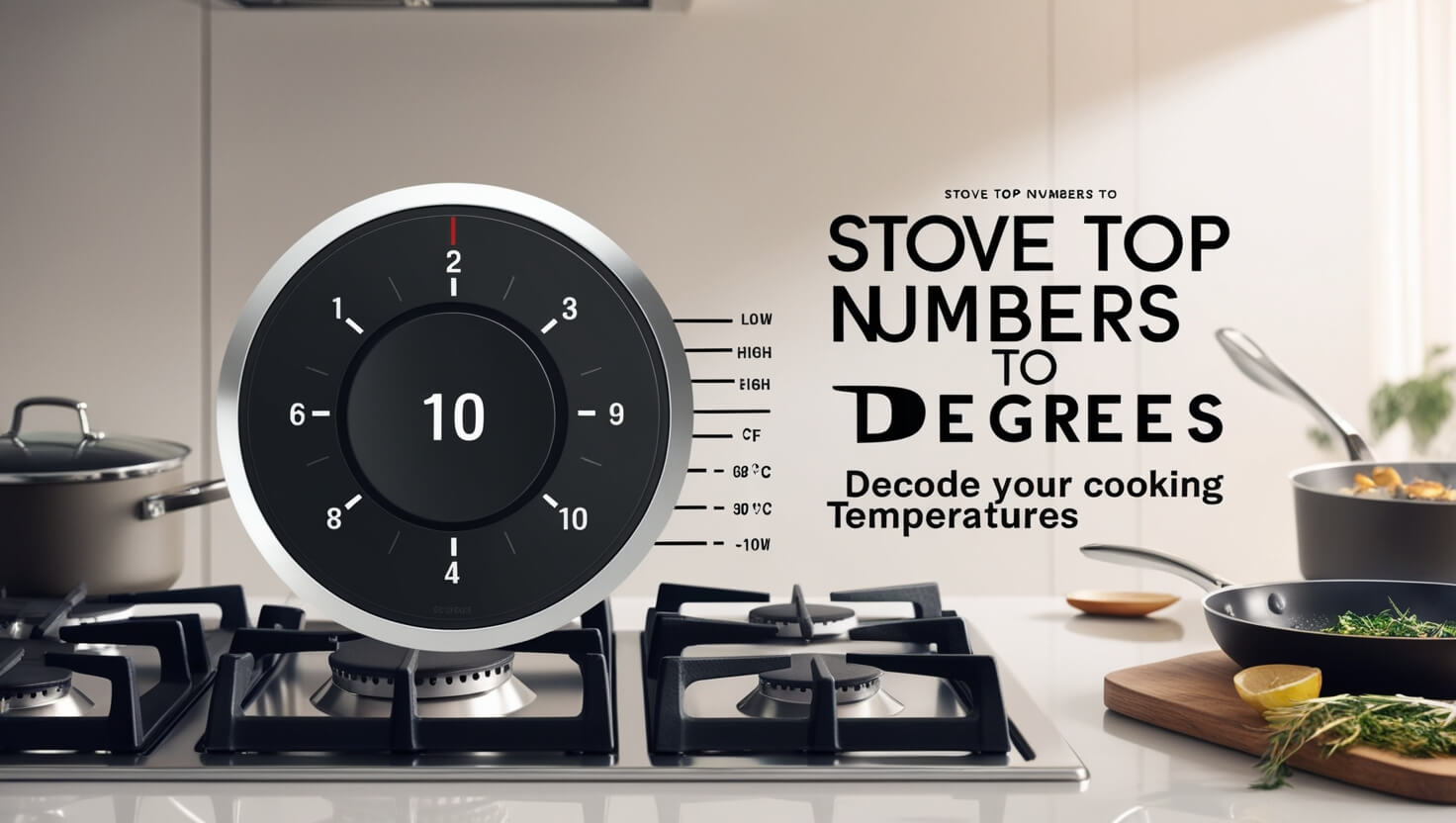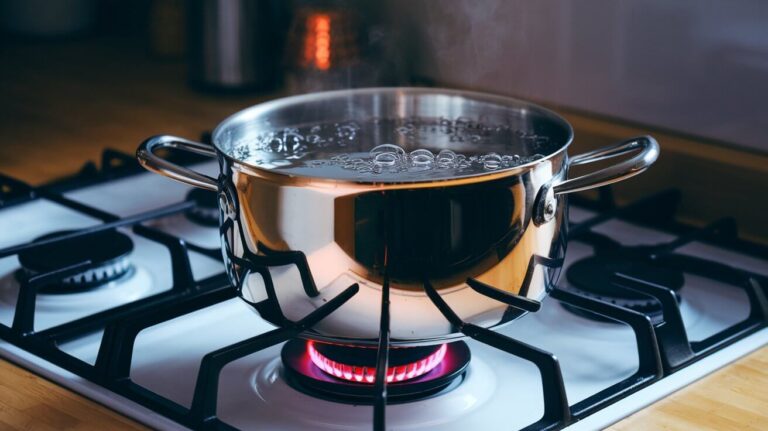
Have you ever stared at your stove’s knobs, wondering what those mysterious numbers mean? You’re not alone. Stove top numbers typically correspond to specific temperature ranges, with 1-3 representing low heat (200°F-300°F), 4-6 for medium heat (300°F-400°F), 7-8 for medium-high heat (375°F-450°F), and 9-10 for high heat (450°F-500°F+). This guide cracks the code of stove top numbers, making you more confident in the kitchen.
The Basics of Stove Top Temperature Control
Different Types of Stove Top Controls
Stove tops come in various styles, each with its own temperature control system. Most use numbered dials, typically on a 1-10 or 1-6 scale. Some have simple “Lo” and “Hi” markings, while others use descriptive terms like “Simmer” or “Max.”
Why Understanding Stove Top Numbers Matters
Knowing how to translate stove top numbers to actual temperatures is crucial for successful cooking. It helps you follow recipes accurately, avoid burning food, and achieve consistent results. Plus, it gives you more control over your cooking, allowing you to fine-tune temperatures for perfect dishes every time.
Decoding Stove Top Numbers
Common Numbering Systems (1-10 and 1-6 scales)
The 1-10 scale is most common on electric stoves. On this scale, 1 is the lowest heat setting, and 10 is the highest. For 6-point dials, 1 is still the lowest, but 6 represents the maximum heat.
Low, Medium, and High Heat Settings
Generally, low heat falls between 1-3, medium heat between 4-6, and high heat from 7-10 on a 10-point scale. On a 6-point scale, low is 1-2, medium 3-4, and high 5-6. These ranges give you a good starting point for adjusting your cooking temperatures.
Stove Top Numbers to Degrees Fahrenheit
Low Heat (1-3): 200°F to 300°F
Low heat is perfect for simmering sauces, melting chocolate, or keeping food warm. It’s gentle enough to cook delicate items without burning them. Use these settings when you need to cook food slowly or maintain a steady, low temperature.
Medium Heat (4-6): 300°F to 400°F
Medium heat is the workhorse of many kitchens. It’s ideal for sautéing vegetables, cooking pancakes, or frying eggs. This range gives you enough heat to cook food through without scorching it.
Medium-High Heat (7-8): 375°F to 450°F
Medium-high heat is great for searing meats, stir-frying, or getting a good crust on foods. It provides enough heat to brown food quickly while still cooking it through.
High Heat (9-10): 450°F to 500°F+
High heat is reserved for boiling water, searing steaks, or getting a wok smoking hot for authentic stir-fries. Use it sparingly and with caution, as food can burn quickly at these temperatures.
Gas Mark Conversions
Gas Mark to Fahrenheit Chart
For those with gas stoves, here’s a quick conversion chart:
- Gas Mark 1: 275°F
- Gas Mark 4: 350°F
- Gas Mark 6: 400°F
- Gas Mark 8: 450°F
Using Gas Marks in Recipes
Many recipes, especially from the UK, use gas marks. Knowing these conversions helps you adapt recipes to your stove, whether it’s gas or electric.
Electric vs. Gas Stove Top Temperature Control
Differences in Heat Distribution
Electric stoves often provide more even heat distribution across the burner. Gas stoves, on the other hand, concentrate heat in the center where the flame is strongest.
Responsiveness and Precision
Gas stoves offer more responsive temperature control. You can change the heat instantly by adjusting the flame. Electric stoves take longer to heat up or cool down, requiring more anticipation in your cooking.
Practical Cooking Applications
Simmering and Low Heat Cooking
Simmering is a gentle cooking method that requires low heat, typically between 185°F and 205°F. It’s perfect for making stocks, soups, or slow-cooking tough cuts of meat. On most stoves, this falls between 2 and 3 on the dial.
Sautéing and Medium Heat Techniques
Sautéing usually requires medium heat, around 325°F to 375°F. This temperature range allows foods to brown nicely without burning. Aim for 4-6 on your stove’s dial for most sautéing tasks.
High Heat Cooking Methods
High heat cooking, like stir-frying or searing, often needs temperatures above 400°F. Use settings 7-10 for these techniques, but keep a close eye on your food to prevent burning.
Tips for Accurate Temperature Control
Using Visual Cues
Look for visual signs to gauge your pan’s temperature. A drop of water should sizzle gently on medium heat, while it will dance and evaporate quickly on high heat.
Adjusting for Your Specific Stove
Every stove is unique. Experiment with yours to learn its quirks. Some run hotter or cooler than others, so you may need to adjust recipes accordingly.
Common Cooking Temperature Ranges
Ideal Temperatures for Various Dishes
- Pancakes: 350°F (medium heat)
- Steak searing: 450°F+ (high heat)
- Rice cooking: 200°F-250°F (low heat after initial boil)
Avoiding Common Temperature Mistakes
Don’t start with high heat for most dishes. It’s easier to increase heat than to cool down an overheated pan. Also, remember that empty pans heat up much faster than those with food in them.
Advanced Temperature Control Techniques
Multi-Zone Cooking
Use different burners at different temperatures to cook multiple components of a meal simultaneously. For example, sear meat on high heat while gently simmering a sauce on low.
Temperature Layering in One-Pan Dishes
Start with high heat to sear meats, then reduce to medium or low to finish cooking. This technique builds flavor while ensuring food is cooked through.
Troubleshooting Stove Top Temperature Issues
Dealing with Hot Spots
If your pan has hot spots, rotate it occasionally for even cooking. Or invest in heavy-bottomed pans that distribute heat more evenly.
Addressing Uneven Heating
For electric stoves with uneven heating, try using a heat diffuser. This simple tool helps spread heat more evenly across the bottom of your cookware.
Safety Considerations
Preventing Overheating
Never leave a heated stove unattended. Oils can smoke and ignite if overheated. If you see smoke, carefully remove the pan from heat and let it cool down.
Safe Handling of High-Temperature Cookware
Always use oven mitts or pot holders when handling hot cookware. Remember that handles can get hot too, especially on gas stoves where flames might lick up the sides of pans.
Conclusion
Understanding stove top numbers and their corresponding temperatures is a game-changer in the kitchen. It allows you to cook with precision, follow recipes accurately, and even create your own culinary masterpieces. Remember, practice makes perfect. The more you cook and experiment with different heat levels, the more intuitive it will become.
Connecting stove top numbers to degrees transforms your cooking. You’ll go beyond following recipes to creating your own dishes. Turn those dials with confidence and unleash your kitchen creativity!






